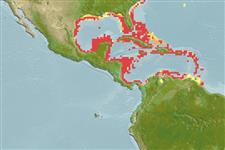>
Tetraodontiformes (Puffers and filefishes) >
Tetraodontidae (Puffers) > Canthigasterinae
Etymology: Canthigaster: Greek, kanthos = the outer or inner corner of the eye, where the lids meet, 1646 + Greek, gaster = stomach (Ref. 45335).
More on author: Bloch.
Environment: milieu / climate zone / depth range / distribution range
ນິເວດວິທະຍາ
ສັດທະເລ ກ່ຽວກັນຫີນ; ລະດັບຄວາມເລິກ 1 - 40 m (Ref. 43205). Tropical; 34°N - 8°N, 98°W - 59°W
Western Central Atlantic: South Carolina, USA and Bermuda to Tobago and the Lesser Antilles. All Canthigaster specimens so far recorded from Madeira belong to Canthigaster capistrata (Ref. 43205).
ຂະໜາດ / ນ້ຳໜັກ / Age
Maturity: Lm ? range ? - ? cm
Max length : 12.0 cm TL ຕົວຜູ້/ບໍ່ມີເພດ; (Ref. 26340)
ຄີ (ໜາມ)ແຂງຢູ່ຫຼັງປາ (ທັງໝົດ) : 0; ຄີຫຼັງຂອງປາ (ຄີອ່ອນ) (ທັງໝົດ) : 10 - 11; ຄີ(ໜາມ) ແຂງຢູ່ຄີກົ້ນປາ
ກຸ່ມປາກະດູກແຂງ
ຄວາມຖີ່ຂອງກຸ່ມຖ່າຍທອດພັນ
ປາທີ່ມີການເຄື່ອນຍ້າຍຈາກທະເລໄປຫານ້ຳຈືດ ແລະນ້ຳຈືດຫາທະເລ
ປາທີ່ມີການເຄື່ອນຍ້າຍຈາກທະເລແລະໄປໄຂ່ຢູ່ນ້ຳຈືດ
ຄີກົ້ນຂອງປາ
ສັດທີ່ມີກະດູກສັນຫັຼງ
ການຖ່າຍທອດທາງກຳມະພັນຈາກພໍ່ແມ່ຫາລູກ: 0; ຄີກົ້ນຂອງປາ: 9. Distinguished from all other Atlantic species by a short upper dark longitudinal stripe, presence of few spots on flank and dorsum, and absence of a conspicuous (larger than eye) spot on the dorsum. The upper dark longitudinal stripe extends from caudal-fin dorsal margin to the vertical through dorsal-fin base. Although a horizontal line of dark spots extends anterior to the anterior portion of the horizontal dark stripe in some specimens, and sometimes even surpasses the dorsal fin base, this line of spots never forms a continuous stripe. Also distinguished by the absence of vertically oriented bars on the caudal fin and by the presence of bars on the snout (Ref. 43205).
Inhabits reefs and marginal habitats such as seagrass beds (Ref. 43205). Diet consists of seagrass, sponges, crabs and other crustaceans, mollusks, polychaete worms, sea urchins, starfishes, hydroids and algae (Ref. 13442). Monogamous (Ref. 52884).
Life cycle and mating behavior
ການຈະເລີນເຕັມໄວ | ການສືບພັນ | ການວາງໄຂ່ | ໄຂ່ | ຄວາມດົກຂອງໄຂ່ປາ | ຕົວອ່ອນ
Oviparous (Ref. 205). No parental care according to Ref. 38836.
Moura, R.L. and R.M.C. Castro, 2002. Revision of Atlantic sharpnose pufferfishes (Tetraodontiformes: Tetraodontidae: Canthigaster), with description of three new species. Proc. Biol. Soc. Wash. 115(1):32-50. (Ref. 43205)
IUCN Red List Status (Ref. 130435: Version 2024-2)
Threat to humans
Harmless
Human uses
ການປະມົງ: ເປັນສີນຄ້າ; ຕູ້ປາ: ເປັນສີນຄ້າ
ເຄື່ອງມື
Special reports
Download XML
ແຫຼ່ງອີນເຕີເນັດ
Estimates based on models
Preferred temperature (Ref.
123201): 23.6 - 28, mean 26.4 °C (based on 220 cells).
Phylogenetic diversity index (Ref.
82804): PD
50 = 0.5000 [Uniqueness, from 0.5 = low to 2.0 = high].
Bayesian length-weight: a=0.03631 (0.01554 - 0.08482), b=2.88 (2.69 - 3.07), in cm total length, based on LWR estimates for this Genus-body shape (Ref.
93245).
ຊັ້ນເຂດຮ້ອນ (Ref.
69278): 3.3 ±0.1 se; based on diet studies.
ຄວາມຢືດຢຸ່ນ (Ref.
120179): ສູງ, ປະຊາກອນຕຳ່ສຸດທີ່ໃຊ້ເວລາສອງໜ້ອຍກວ່າ 15 ເດືອນ (Preliminary K or Fecundity.).
Fishing Vulnerability (Ref.
59153): Low vulnerability (10 of 100).
Nutrients (Ref.
124155): Calcium = 102 [47, 253] mg/100g; Iron = 0.966 [0.474, 2.280] mg/100g; Protein = 18.2 [16.0, 20.4] %; Omega3 = 0.133 [0.065, 0.262] g/100g; Selenium = 35.1 [17.1, 79.4] μg/100g; VitaminA = 52.6 [14.7, 200.9] μg/100g; Zinc = 1.59 [1.01, 2.41] mg/100g (wet weight);
